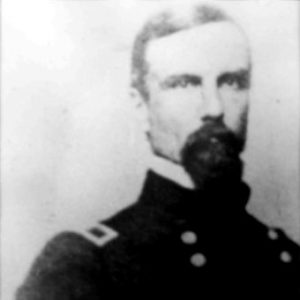calsfoundation@cals.org
John Wynn Davidson (1824–1881)
John Wynn Davidson was a United States army officer who led the cavalry contingent of the Union army that captured Little Rock (Pulaski County) in 1863 and who subsequently feuded with Major General Frederick Steele about Federal policy in the state.
John Wynn Davidson was born on August 18, 1824, in Fairfax County, Virginia, the son of William B. Davidson and Catherine Davidson. His father was a West Point graduate and veteran of the Seminole wars in Florida, and his grandfather was a general officer in the American Revolution. John Wynn Davidson followed his father into the army, graduating from the U.S. Military Academy at West Point in 1845. He served frontier duty in Kansas and Wisconsin before fighting in California during the U.S.-Mexican War as a second lieutenant in the First Dragoons. Davidson fought Indians in New Mexico and California, suffering wounds in a fight with Jicarilla Apaches, before being promoted to captain in 1855.
Davidson was serving at Fort Tejon, California, when the Civil War broke out, and he remained loyal to the United States. He was commissioned a major in the Second Cavalry on November 14, 1861, and transferred to assist in the defenses of Washington DC. He was made a brevet brigadier general of volunteers on February 3, 1862, and fought in the Peninsular Campaign in Virginia before transferring to command the District of St. Louis, Missouri, in August. In 1863, he was in command of the Army of Southeast Missouri and participated in the pursuit of John Sappington Marmaduke’s Confederates during their failed raid into Missouri in in May. The veteran’s regular-army discipline did not sit well with his volunteer soldiers, with one trooper writing home that “our men are very much put out with Gen. Davidson and some of them are trying to kill him, in which undertaking I hope they will be successful.”
In July 1863, Davidson led his 6,000 troops into Arkansas in response to a rumor that Major General Sterling Price was marching toward Missouri following the Battle of Helena. Though this turned out to be untrue, Davidson’s advance continued, and he coordinated with an infantry force from Helena (Phillips County) in the campaign to capture Little Rock under the overall command of Major General Frederick Steele. Steele’s 6,000 foot soldiers played little role in the combat operations of the campaign, and Davidson’s cavalry fought the enemy at Brownsville (Lonoke County) on August 25 and Bayou Meto on August 27 before commencing the final assault on Little Rock on September 10, where he ordered his men “to make a dash upon he city and capture it,…though it cost us one of our regiments.” Brushing aside Confederate defenders in the Engagement at Bayou Fourche, Davidson’s troops raced into Little Rock and accepted the city’s surrender that evening. Davidson apparently smoothed things over with his troops during the Little Rock Campaign, and the men of the First Iowa Cavalry later presented him with a ceremonial sword.
Steele appointed Davidson as military governor of Little Rock, but the two did not get along, in part because of Davidson’s resentment at being superseded by Steele as commander of the Little Rock Campaign and also because of Davidson’s disagreement with what he saw as Steele’s conciliatory policy toward rebellious Arkansans. Davidson was replaced by Brigadier General E. A. Carr on January 31, 1864, but his assessment of Steele’s leadership to the Senate Committee on the Conduct of the War helped lead to Steele’s eventual removal from command of the Seventh Army Corps.
Davidson later led the cavalry of the Department of West Mississippi and, on March 13, 1865, he was made brevet major general of both volunteers and the U.S. Army. Following the war, he reverted to his regular army rank and served in the inspector general’s office and as a professor of military tactics at Kansas Agricultural College before taking command of the African-American Tenth Cavalry Regiment, where he received the nickname “Black Jack.” Davidson served in Texas and the Indian Territory before being commissioned colonel of the Second U.S. Cavalry on March 20, 1879. He was in command at Fort Custer, Montana, when his horse slipped on ice and fell on him. He died on June 26, 1881, while recuperating in St. Paul, Minnesota. Initially buried at Bellefontaine Cemetery in St. Louis, his remains were moved to Section Two in Arlington National Cemetery in 1911.
For additional information:
Anderson, H. Allen. “John Wynn Davidson.” The Handbook of Texas Online. https://tshaonline.org/handbook/online/articles/fda80 (accessed April 20, 2023).
Christ, Mark K. Civil War Arkansas, 1863: The Battle for a State. Norman: University of Oklahoma Press, 2010.
Davidson, Homer K. Black Jack Davidson: A Cavalry Commander on the Western Frontier. Glendale, CA: Arthur H. Clarke Co., 1974.
“John Wynn Davidson.” http://www.arlingtoncemetery.net/jwdavidson.htm (accessed April 20, 2023).
Warner, Ezra J. Generals in Blue: Lives of the Union Commanders. Baton Rouge: Louisiana State University Press, 1964.
Mark K. Christ
Little Rock, Arkansas
 Civil War through Reconstruction, 1861 through 1874
Civil War through Reconstruction, 1861 through 1874 Military
Military John Davidson
John Davidson 




Comments
No comments on this entry yet.